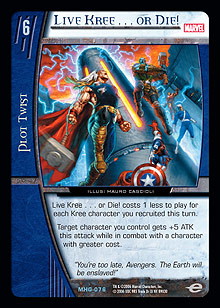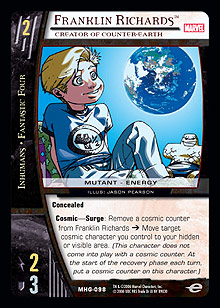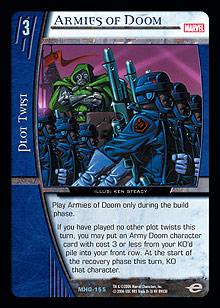
Last week was the last article on Heralds of Galactus Sealed Deck, but we will not be continuing on with Booster Draft just yet. Over the duration of this column, I have sometimes found it hard to put my writing about Draft into an easily understandable context. While I am clearly not the be-all and end-all of Vs. System Sealed play, I do tend to look at things in a very particular way that is sometimes not easily grasped by the more traditional drafter. In an effort to alleviate some of this confusion, I have written a bridging article referencing my ten rules of Heralds of Galactus Booster Draft. You may not agree with some of these—you may not agree with any of them—but at least when you read my articles on Booster Draft in this set, you will have a better idea of where I am coming from.
1. Kree press is the default best strategy in Heralds of Galactus Booster Draft.
 By now, you have probably heard about the incredible potency of the press mechanic. You should believe the hype. Press might not have fundamentally changed the way people play Vs. System, but it is definitely one of the more original and reliable mechanics the game has seen so far. The tension between off-curve and on-curve decks has never been as pliable as it is with press. With the right deck or the right draw, you can choose to play it safe with an on-curve character or you can fan out several smaller characters for a multi-pronged attack. The options have never seemed so good.
By now, you have probably heard about the incredible potency of the press mechanic. You should believe the hype. Press might not have fundamentally changed the way people play Vs. System, but it is definitely one of the more original and reliable mechanics the game has seen so far. The tension between off-curve and on-curve decks has never been as pliable as it is with press. With the right deck or the right draw, you can choose to play it safe with an on-curve character or you can fan out several smaller characters for a multi-pronged attack. The options have never seemed so good.
Simply put, the best Kree press decks tend to be better than the other strategies available in Heralds of Galactus Sealed. However, without the right cards (the good press 2-drops and 3-drops), the deck isn’t really viable. What this means is that while there is a default best deck in the format, the narrowness of the strategy balances it out. You need to be able to recognize the conditions that allow you to draft Kree so that you can take the opportunity when presented with it, but you also need to be aware of the situations that aren’t conducive to drafting Kree so you don’t go overboard. Kree should be your default strategy, but when the key cards aren’t available, you should be ready to look elsewhere.
2. Kree is the best mono-team deck but the worst team-up deck.
Drafting mono-team decks is a luxury that isn’t always available to you. Sure, there will often be that player who manages the perfect seat in the Draft and is able to wheel cards you would have considered first picks en route to the perfect archetypal deck. Fortunately, though, as you draft with opponents of higher and higher skill, this is less and less likely to occur. By the time you hit the Pro Circuit, you need to be able to spot synergies between teams if you want to be successful, because drafting single-team decks is definitely not a strategy on which you can rely.
I love the Kree team, but they are clearly the worst team to have to team-up with in Heralds of Galactus Draft. The exclusivity of press to their team and the general weakness of their late game (as something of a compensation) means that you tend to be “press or bust” when drafting Kree. This doesn’t mean that you can’t play a half-Kree deck, but you really need to know what you’re doing. When drafting Kree, be careful to pick the right characters so that if things don’t go so well, you can jump ship before it’s too late.
3. The Inhumans are a signaling team, not a forcing team.
There is a great deal of debate concerning the competing merits of forcing a strategy in a Draft and the accuracy of following signals from the player passing to you. While I couldn’t do this topic justice in an article as brief as this, it is key that you recognize which is appropriate at which times. Sometimes, a strategy might be so strong that getting a foot in the door is all that’s necessary for you to want to cut the next player out of that team or style of deck completely. At other times, a strategy or style of play is so dependent on cheap, late picks that you need to be able to guarantee those before getting in too deep.
You should be wary of committing to the Inhumans too early. Some notable players have commented that the team itself isn’t very heavy on playables and that it relies a lot on key cards; in general, those players are right. While the Inhumans are my favorite team to draft in this format, I would warn players to proceed with care when drafting this team and ensure that they have the cards they need before committing to the team fully.
4. The Inhumans are really only strong when you draft nearly all concealed characters.
 Concealed characters allow better players to assert themselves against weaker players. This is because concealed characters allow better players more attacks and thus more chances to control the interaction of characters. As such, there is a great deal of advantage and subtlety available to the player drafting concealed characters. In recent sets, one team has had a greater focus on concealed than the others, and in this set it is the Inhumans
Concealed characters allow better players to assert themselves against weaker players. This is because concealed characters allow better players more attacks and thus more chances to control the interaction of characters. As such, there is a great deal of advantage and subtlety available to the player drafting concealed characters. In recent sets, one team has had a greater focus on concealed than the others, and in this set it is the Inhumans
So many elements of the team point to advantage through concealed characters: the DEF-boosting theme of the affiliation; the power of cosmic—surge; even the ability of Franklin Richards, Creator of Counter-Earth. Like the Kree team and press, the Inhumans gain much simply by staying true to those themes. The 3-drop and 4-drop concealed characters are crucial to the overall plan of creating advantage through active use of the hidden area. The visible characters just don’t have the same level of support.
5. Heralds of Galactus plays until turn 8.
Why I feel this is the best Draft format Vs. has seen apart from The Avengers has a lot to do with the importance of both turn 1 and turn 8. In no other set was turn 8 as easily played for as it is in this set. Even slower formats like Justice League of America and Green Lantern Corps played turn 8 more incidentally than deliberately. In Heralds of Galactus Booster Draft, the namesake team of the set has more than a reasonable chance of reaching that summit.
As a team, Heralds of Galactus not only enjoys a variety of cards that can lead to longer games (in turns), but those cards also have a lot more synergy than similar strategies from other sets. Endurance gain, high DEF, cards that negate abilities, and an abundance of card drawing really allow you to immerse your opponent in cardboard quicksand. The gravy is that the team even has an uncommon 8-drop—proof in design if ever there needed to be any.
6. Heralds of Galactus will be the most over-drafted team at the table.
The namesake teams of the set tend to be the best known, and this usually means that the inexperienced drafters at your table will fall back on familiar faces. As a result, it can be hard to find the right deck in the most popular team in the set, as the important cards tend to be taken away from you. Heralds of Galactus Booster Draft definitely does not buck this trend. In the Drafts I have done with this set, I have nearly always seen at least four Heralds drafters, and on one notable occasion, a table actually had six drafters going for Heralds. This can be frustrating in some regards, but can also be a boon if you can evade the stampede and slip quietly into another team.
While I think that the reason given above holds true (that familiarity with the characters is too tempting for novice players), I also think there is more to it in this format. Heralds of Galactus Booster Draft is quite a complex format. As noted above, turn 1 can matter as much as turn 8. This means that for most players, the safe on-curve deck is where they will find a warm space to make easy picks and get the deck they feel comfortable playing. As a result it can be difficult to get into Heralds because the picks often dry up very quickly.
7. Doom Army is an extremely narrow strategy.
 At the start of a format when people are still trying to work things out, commentators like to begin referring to certain strategies as format-defining. Typically, there are better and worse ways of drafting each team. I have already talked about the difficulty of getting into Kree and the Inhumans when you aren’t pursuing the team from an archetypal position. After Yoel Izsak won the most recent $10K New York, many people talked up the strength of the Doom Army deck. While it is a powerful deck when firing on all cylinders, I am not sure how easily you can get it.
At the start of a format when people are still trying to work things out, commentators like to begin referring to certain strategies as format-defining. Typically, there are better and worse ways of drafting each team. I have already talked about the difficulty of getting into Kree and the Inhumans when you aren’t pursuing the team from an archetypal position. After Yoel Izsak won the most recent $10K New York, many people talked up the strength of the Doom Army deck. While it is a powerful deck when firing on all cylinders, I am not sure how easily you can get it.
What I don’t like about the team is that most of the Army characters have really narrow alternate recruit costs. This is probably a good thing (because otherwise they would run rampant), but I think that cards like Elite Doom Guards ◊ Army and Moloids ◊ Army are harder to get into play than people think. There are facilitators (like Armies of Doom) to help them out, but I much prefer to rely on the free characters like Valeria Von Doom, Heir to Latveria to power the useful KO effects the team provides.
8. The Doom characters are highly splashable.
Sometimes, even your best efforts can leave you feeling bewildered—like halfway through that second pack when you pass the third good pick from a team you didn’t think was available while you were making picks in the first pack. Other times, you find that you just don’t get the right number of cards you need to make that optimal 3-0 deck. Often, you just have to bite the bullet and splash a few characters into your mono- or dual-team decks.
I find that the Doom team has the best candidates for this. Ultron ◊ Ultron 11, Army is an excellent character that doesn’t have to go only in Doom decks. Dr. Doom, Sorcerous Savant is the best character in the format that costs 6 or more. Even Technarx, Cyborg General is splashable with a loose Team-Up here or there. Overall, I think that the Doom team can provide you with a lot of filler characters, and as such, they are often taken early in the Draft as flexible picks even if players don’t go into the team later on. Keep a lookout for them if you feel that your Draft is coming apart at the seams.
9. Skrulls are an off-curve deck.
The small teams of a set are always a bit of an oddity. Small teams are generally the place for wacky combo facilitators or ultra-powerful combat characters with enormous drawbacks. Small team characters need to stand out, as they don’t really have a whole raft of non-character support, or even teammates, to cover their shortcomings.
The Skrulls are probably the best small team in Sealed Pack ever. Paibok, The Power Skrull is very powerful. The team as a whole lends itself to more of an off-curve strategy than a straight on-curve one. This is made especially true because their 6-drop is rare and their Team-Up helps out weenies. Overall, Paibok and Act of Defiance, Team-Up are the best cards to draft for the team. More than this (because you can’t draft a mono-Skrull deck), you are looking for cards and Team-Ups that will help you make the most of powerful but fragile cards like Captain America, Skrull Imposter and Wolverine, Skrunucklehead. These tend to be cards like Franklin Richards and Extended Family, Team-Up, so Inhumans are often a good choice. Their concealed characters often allow for better off-curve plans to begin with.
10. The Infinity Watch is an on-curve team.
I really like the effort that went into building nuance into the small Heralds of Galactus teams. While small teams have always been playable in some form or another, the ones in Heralds require more skill than the ones in previous sets.
While the Skrulls are a faster and more aggressive team, the Infinity Watch is more controlling and reactive. They tend to have larger DEF values than characters in other teams. Drafting this team as an adjunct to an otherwise on-curve strategy like Heralds seems to be the way to go. The card I previewed for this site, Moondragon, Protector of the Mind Gem, can power a deck all by herself; she has tremendous synergy with Heralds card-drawing cards and The Power Cosmic Unleashed. Adam Warlock, Protector of the Soul Gem is another powerful on-curve character that can allow you to play very conservatively in the hopes of a big late game. Even Gamora, Protector of the Time Gem can be too large for a lot of characters to deal with. This team is definitely a feature of this format.